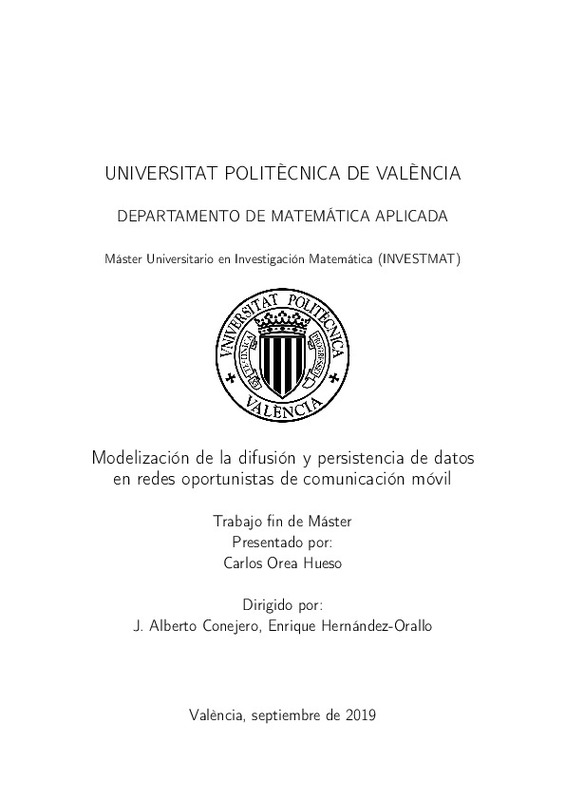JavaScript is disabled for your browser. Some features of this site may not work without it.
Buscar en RiuNet
Listar
Mi cuenta
Estadísticas
Ayuda RiuNet
Admin. UPV
Modelización de la difusión y persistencia de datos en redes oportunistas de comunicación móvil
Mostrar el registro sencillo del ítem
Ficheros en el ítem
| dc.contributor.advisor | Conejero Casares, José Alberto
|
es_ES |
| dc.contributor.advisor | Hernández Orallo, Enrique
|
es_ES |
| dc.contributor.author | Orea Hueso, Carlos
|
es_ES |
| dc.date.accessioned | 2019-10-25T10:57:08Z | |
| dc.date.available | 2019-10-25T10:57:08Z | |
| dc.date.created | 2019-09-19 | |
| dc.date.issued | 2019-10-25 | es_ES |
| dc.identifier.uri | http://hdl.handle.net/10251/129515 | |
| dc.description.abstract | [EN] In this thesis, we will study how mobile devices can share and keep information and what are the best protocols to achieve different goals. Moreover, we will try to guess which mathematical models best describe our situation so we can do precise forecasts. The two main traits that distinguish MANETs (Mobile ad hoc Networks) and traditional technologies are the following: First, there is no fixed infrastructure, since the messages are carried and received/sent by the nodes themselves, and second, those nodes are, of course, generally moving. One of the main problems of those networks is to assure that the messages will arrive from the node who generated the message to the one we want to receive it, if necessary, jumping from one to another until reaching to the objective. This can fail for multiple reasons: one of the nodes in between has not enough storage capacity, they are too far apart, etc. For this reason, we need to simulate different protocols to check which ones are the best, and for this, we need high-quality traces whose behavior assimilate to real-life moving nodes. The steps that we will follow in this work are the following: • Obtain information from a real-life scenario (“La plaza de San Vicente Ferrer”) • Feed this data into PEdSim to realistic traces. • Use these traces into ONE simulator to check the performance of a protocol. • Understand different mathematical models used to describe these processes. To obtain the above-mentioned information from this square, we visited “La plaza de San Vicente Ferrer” and one by one, wrote done from where to where people moved and how long it took them. Then, other metrics such as speed can be directly calculated. After that, we used this data, and altogether with the design of the square, we simulated it to get the traces. We right after simulated them with ONE. Lastly, different mathematical models can be used in this situation, such as: SIR type models and dynamic graphs, etc. They are generally used in epidemiological disease situations, where there is a group of infected people, susceptible people, and recovered people. Such models admit many different nuances, so it is easily fitted into MANETs experiments. The analogy is clear, since we have nodes without the message (susceptible), and nodes with it (infected) which will infect other nodes if some requirements are met The first ones are valid as long as the population remaining in the place is large enough. The second ones are more accurate when the size of the population in the place is small. We will describe the theoretical part of both models and we will see how the second one work with the data obtained. | es_ES |
| dc.description.abstract | [ES] Con la llegada de la tecnología 5G y el esperado cresimiento explosivo de estos dispositivos, el ancho de banda puede resultar limitante. Una opción para mitigar este efecto es la descarga directa por WIFi entre dispositivos próximos. Las comunicaciones en redes móviles oportunistas tienen lugar cuando se establecen contactos efímeros entre nodos móviles mediante comunicación directa. A partir de trazas movilidad reales y gracias al simulador PedSim (PEDestrian crowd SIMulation) modelizamos la disfusión y persistencia de la información en un determinado recinto con el paso del tiempo, estudiando la relación entre los distintos parámetros y contrastando los resultados con otros modelos existentes. | es_ES |
| dc.language | Inglés | es_ES |
| dc.publisher | Universitat Politècnica de València | es_ES |
| dc.rights | Reserva de todos los derechos | es_ES |
| dc.subject | Comunicaciones móviles 5G | es_ES |
| dc.subject | Redes oportunistas | es_ES |
| dc.subject | Mensajería basada en contactos | es_ES |
| dc.subject | Trazas de movilidad. | es_ES |
| dc.subject | 5G mobile communication | es_ES |
| dc.subject | Opportunistic networks | es_ES |
| dc.subject | Contact-based messaging | es_ES |
| dc.subject | Moility traces. | es_ES |
| dc.subject.classification | MATEMATICA APLICADA | es_ES |
| dc.subject.classification | ARQUITECTURA Y TECNOLOGIA DE COMPUTADORES | es_ES |
| dc.subject.other | Máster Universitario en Investigación Matemática-Màster Universitari en Investigació Matemàtica | es_ES |
| dc.title | Modelización de la difusión y persistencia de datos en redes oportunistas de comunicación móvil | es_ES |
| dc.type | Tesis de máster | es_ES |
| dc.rights.accessRights | Abierto | es_ES |
| dc.contributor.affiliation | Universitat Politècnica de València. Departamento de Matemática Aplicada - Departament de Matemàtica Aplicada | es_ES |
| dc.description.bibliographicCitation | Orea Hueso, C. (2019). Modelización de la difusión y persistencia de datos en redes oportunistas de comunicación móvil. http://hdl.handle.net/10251/129515 | es_ES |
| dc.description.accrualMethod | TFGM | es_ES |
| dc.relation.pasarela | TFGM\115100 | es_ES |






